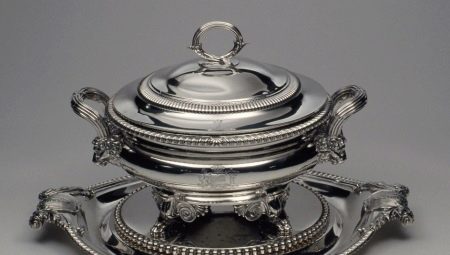In its pristine condition, natural silver is a rather fragile material. To strengthen it, various ligature additivesthat must comply with the generally accepted percentage system. A system indicating the composition of a precious alloy is called testing, and itself the sample is applied to the silver product in the form of a mark. Craftsmen working with precious metals cannot independently put samples, and in order to exclude the appearance of fakes, the mark on finished products is put only in State Assay Office.
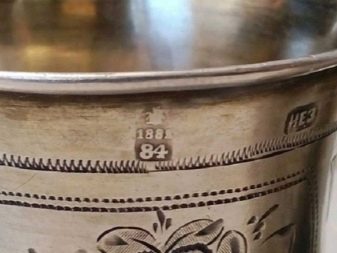

Branding History
When marking affixed to all silver products, numbers and letters are used. And if jewelry masters of past centuries marked their products, putting on them full information, including the name of the master, the value of the product, the date of its manufacture, then the modern stigma on silver has very miniature sizes, and you can only read it using special image-magnifying devices.
Marking of products made of precious silver alloys has its own history and stages of formation. Moreover, in each country this happened in its own way. According to historical data, in Russia the decree on the first stamping on precious metals is dated 1613 year. According to the royal decree, all Russian jewelry masters were required to make a silver alloy, the composition of which repeated the ligature of a foreign coin - thaler. In the thaler, the content of pure silver was at least 93%. The marking of silver was done by specially authorized assay masters, so the stigma soon became known as breakdown. The stigma itself looked like circle with three letters "Є? Ќ", and it was running on 1697 year.

The next tsarist decree on probing standards in Russia has been adopted already in 1896when the territory of the state was divided into 11 districts, each of which had its own brand for silver. Jewelers working at the royal court were allowed to mark silverware with a mark on which was depicted royal coat of arms.
Beginning with 1899 yeara single brand has been approved in the form of a female head with a kokoshnik, head profile was facing to the right but already in 1908 the stigma was changed again, and the image profile began to look to the left. In this case, the mark was added cipher assay office in the form of a Greek letter.
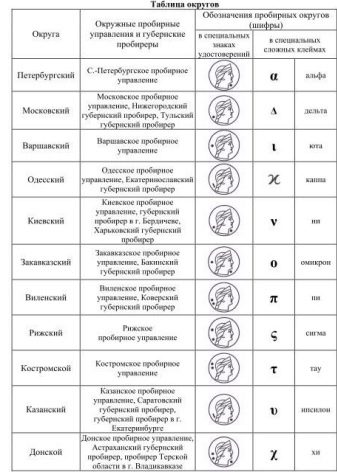
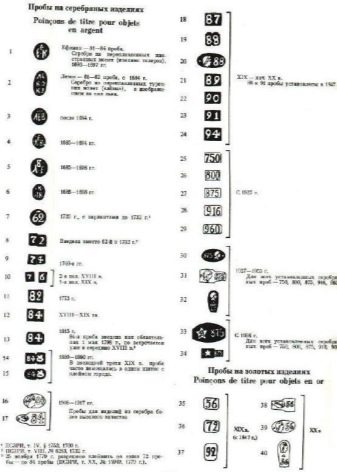
Kinds
From the beginning of the first application of the mark on a silver product to the present day, the type of marking has undergone several dozen changes. Existed officially recognized branding table, but not all types of markings were included in it. Only the most common specimens have survived to our times, the rest have been irretrievably lost.
In the modern world, the mark is mandatory for several types of silver.
- Alloy 800 - it contains at least 80% silver and 20% ligature in the form of copper. Such a composition is subject to rapid oxidation and, as a consequence, to darkening.
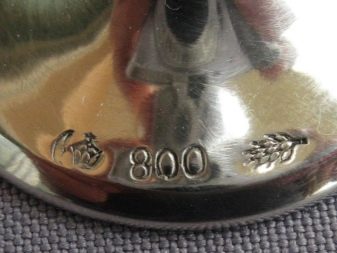
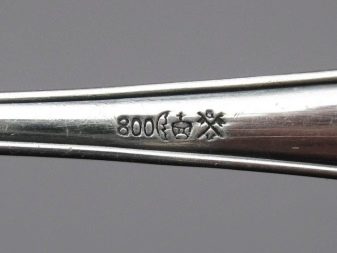
- Alloy 875 - the composition contains not less than 87.5% of noble silver. Such material is most often used for the manufacture of jewelry and cutlery.
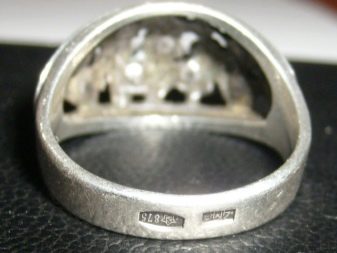

- Alloy 925 - it consists of 92.5% silver, has corrosion resistance, does not have a straw yellow color and lends itself well to forming in the manufacture of products. Alloy is used for the production of jewelry.
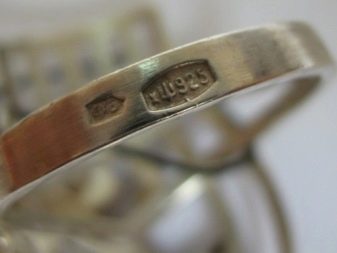
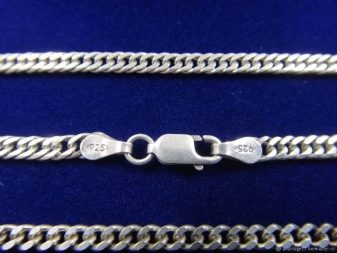
- Alloy 960 - It contains at least 96% silver and is used in highly artistic products with enamel, as well as for the production of expensive jewelry.
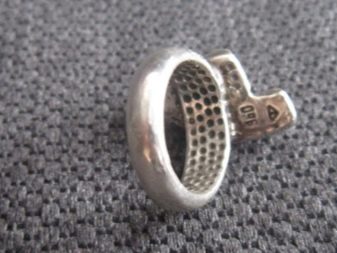

Depending on the percentage composition of the silver metal alloy, its characteristics, as well as the appearance of the finished product.
The higher the content of natural silver, the less yellowness can be seen on jewelry or cutlery made of alloy.
In Russia
After the adoption of a single brand for silver marking in tsarist Russia in 1899, its modifications did not end there. And the old brand has been updated several more times.
- 1908 year - in all districts on the territory of Russia, pre-revolutionary masters had to label their products with a new brand. It looked like a female profile decorated with a kokoshnik. The profile of the female head looked to the right, and the sample itself was indicated in those ancient times as spool.

- 1927 year - after the overthrow of the tsarist regime, the sample for silver also changed. Now the female profile was replaced with an image of the head of a worker in a cap and an image of a hammer was added. Samples were no longer indicated in the spool, but in the metric system. The cipher of the assay office was still designated by the Greek letter.
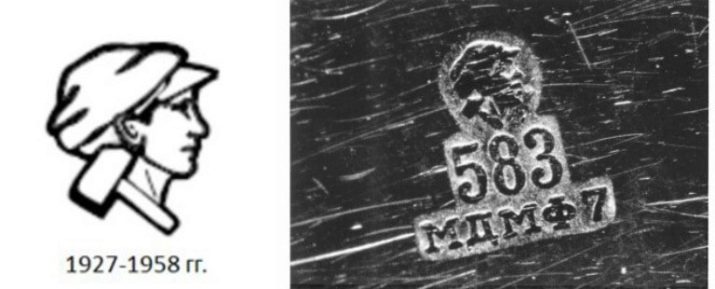
- 1958 year - a new brand for silver marking was reintroduced in the USSR. It contained an image of a sickle and a hammer, which were placed in the center of a large five-pointed star. The code of the assay chamber is already indicated by the capital letter of the Cyrillic alphabet.
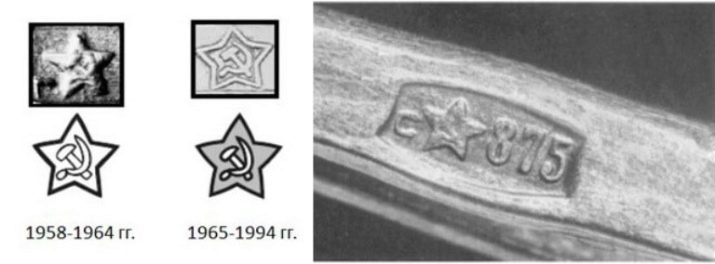
- 1994 year - after the collapse of the USSR, Soviet silver products began to be marked as we can now see on any jewelry made of precious metal. The silver sample contains an indication of the composition of the alloy according to the metric system.

According to the laws in force in our country, without exception, silver products should be marked with a breakdown.
Any items made of precious metals, but without samples and sold, are considered illegal.
In addition to the test, they also put on silver products name day. Any manufacturer - public or private - must have its own name brand. Thus, on the product you will see a sample indicating the composition of the alloy, and a nameplate indicating who produced the product. The nameplate has a manufacturer’s digital code, and every year it changes. All names must be registered in the inspection supervision of probing, therefore, two identical names from different manufacturers can not be. In total, there are 18 assay inspections operating in Russia, and each of them has its own letter in the form of an encrypted marking.
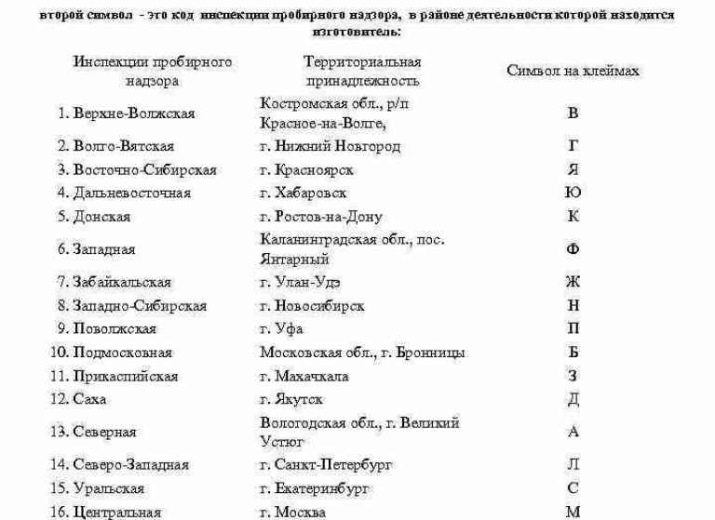
Abroad
There are 2 systems for measuring the composition of silver alloy: carat and metric. Most European and Asian countries use both karate and metric systems. These include France, Germany, Italy, England, Australia, Denmark, USA, Canada and others. Pure silver is taken for 24 carats, and in order to convert this to the metric system, the formula is used: the carat sample should be multiplied by the metric sample and divide the result by 1000.
The first stigma officially registered in the kingdom of England was under King Edward I in 1300. English silverware containing 92.5% silver was labeled with a leopard head.
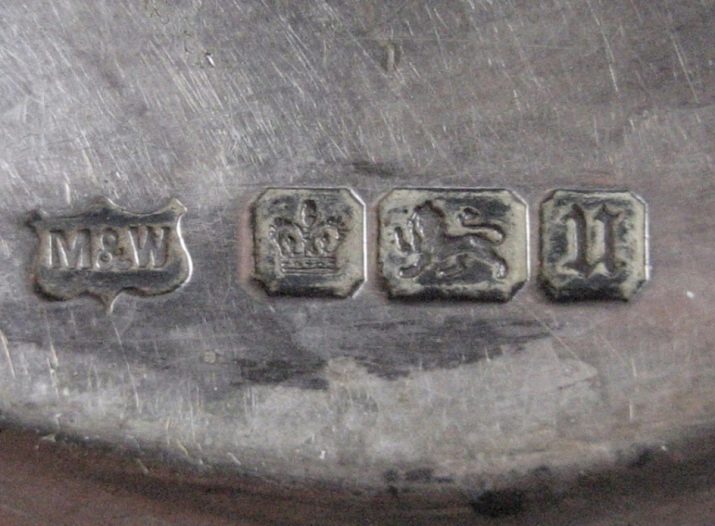
In Germany mention of silver marking dates from 1289 year. According to the royal decree, German silver was marked not only with breakdown, but also with the personal stamp of the master who made the product. The standard of quality silver in Germany at that time was an alloy with a noble metal content of at least 80%. The stigma looked like a crescent turned to the right and the crown of the royal dynasty.

In France after the revolution of 1789, alloys with a pure metal content of up to 95% and 80% were the silver standard. The first mark on French silver was applied in the form of a rooster (symbol of revolution) and the numbers 1 or 2 (i.e. 95% or 80% silver content). Modern stamps now look different - they contain an image Minerva.
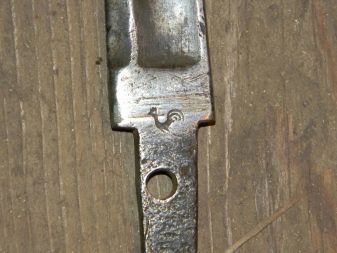
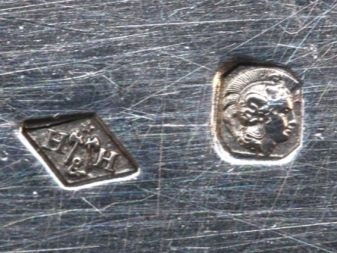
Swedish products made of silver was marked with an imprint of three crowns and a stamp with the letter S, meaning that the alloy contains 83% silver. A Dutch until 1698, a round stamp with the inscription “lion” was used for branding.
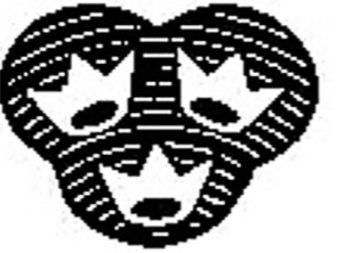
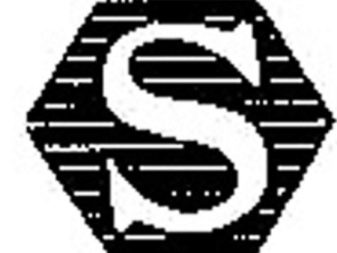
The stigmatization of silver products could not always protect against fakes. Often at foreign auctions in Europe you can see lots of silver products marked with the Faberge workshop. Since the jewelry company's products were in high demand and had worldwide fame, foreign jewelers were willing to create fakes, putting them up for sale at a high price. The stigma of the famous mater Karl Faberge began to be faked during his lifetime.
Application Principles
Currently, the stigma on silver is set in several ways.
- Impact marking - the stamp is knocked out on the finished product. Now this process is carried out automatically using the press, and before this process was carried out manually.

- Electrospark method - the mark is burned out on a silver surface using a special electrical appliance, while the pattern is obtained as a single chain. The process itself is similar to the one that is performed when engraving metal in a souvenir shop - the essence of the process is the same.
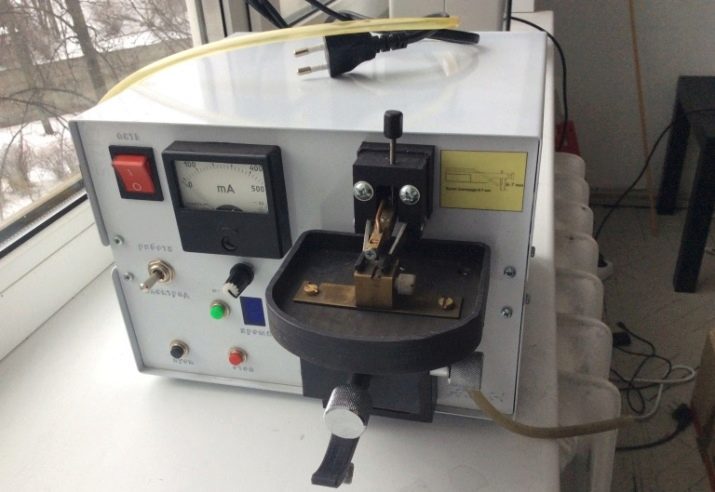
- Laser branding - performed using engraving. The marking on the product is neat, but inconspicuous, and it can only be examined with the help of special magnifying devices in the form of a jewelry magnifier.

All 3 marking methods are used in certain situations. For example, gentle laser marking is performed on a hollow product, since the impact method of applying the mark could destroy its integrity.
Sometimes finished silverware can be coated with a thin layer of gilding, most often it is applied to inexpensive jewelry or silverware.
In this case, the product will be delivered 2 hallmarks: the first will show what material it is made of and its composition, and the second will indicate the composition of the coating alloy.It also happens that precious metal is contained only in the coating, while the base of the product is made, for example, of nickel silver, aluminum or stainless steel. In this case, the mark with the breakdown will be only one, and the mark with letters will show the base material (MN - cupronickel, AL - aluminum, NERZH - stainless steel, etc.). When buying such products, you should be careful and be able to read the stigma, so as not to unknowingly purchase silver-plated cutlery or jewelry at the price of silver (with a high breakdown and cost).


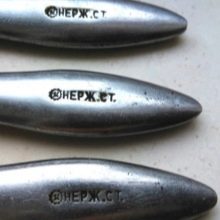
How to distinguish a fake?
Visually distinguishing natural 925 sterling silver from metal alloys similar to it is quite difficult, but quite possible.
Independently at home, you can also determine the authenticity of silver and distinguish it from a fake. There are several simple ways to do this.
- If you bring a regular magnet to the surface of a silver product, then the metal will not be magnetized, since natural silver does not have such properties.
- Hold the silver product in your hands for some time, and you will notice that it heats up very quickly, which cannot be said about other metal alloys - they will remain cold or change their temperature very slightly. Silver has a high degree of thermal conductivity, so it quickly becomes warm from your hands.
- If you take a pharmacy sulfuric ointment and apply it on silver, then after a few hours this place will darken. So silver comes in contact with sulfur, which is manifested by an oxidative reaction. Stainless steel products, for example, after such an experience will remain invariably brilliant.
- A small drop of iodine will help reveal natural silver. Silver becomes black from contact with iodine, and this stain cannot be removed by anything. Other metal alloys do not react to iodine in this way.
- The easiest and most affordable method is checking silver with chalk. If you rub the surface of silver with chalk powder, the oxidation reaction will begin, and silver will begin to cloudy first, and then completely darken - this will be an indicator that you have a silver product.

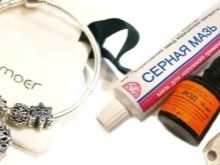
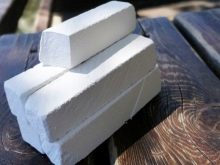
Performing an independent verification of the authenticity of silver, do it carefully and in an inconspicuous place on the product, since the black spots that appear will not be able to be removed by you, as a result of which the jewelry will lose its attractiveness.
If you have a serious expensive purchase of a large batch or valuable jewelry to determine the authenticity of the material from which these items are made, You can invite as an expert a specialist who is well versed in this matter.
How to verify the authenticity of silver at home, see the next video.
